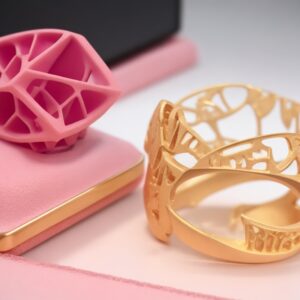Unparalleled Customization

The possibilities for customization through 3D printing in the world of jewelry are extraordinary. Customers no longer have to select from pre-made designs, they can now be integral participants in the creation of their personal adornments. This technology empowers individuals to express their unique style and personality through their jewelry by giving them the freedom to manipulate every aspect of the design.
From the initial concept to the selection of materials and the addition of intricate features, the process is collaborative and highly detailed.Jewelry that embodies deeply personal significance or stories can be crafted. 3D printing also facilitates the recreation of family heirlooms, allowing for modern techniques to preserve historical designs. The fusion of technology and artistry in this field has paved the way for an era where the once-exclusive domain of custom-tailored jewelry is now accessible to a broader audience, offering unparalleled creativity and personalization.
Speed and Efficiency
The advent of 3D printing technology has revolutionized the traditional jewelry-making process, yielding substantial improvements in the speed and efficiency of producing ready-to-wear pieces. Within just a few hours, a digital design can be transformed into a tangible prototype, allowing for swift iteration and refinement. The accelerated production pipeline reduces wait times for customers, who may have had to wait weeks or even months for their customized jewelry to be handcrafted. By enabling jewelers to rapidly produce complex designs on-demand, 3D printing keeps pace with the fast-moving fashion cycles and aligns with the modern consumer’s expectations for prompt service and delivery. This new nimbleness in the manufacturing process allows makers and brands to experiment with new concepts without substantial risk, streamlining the path from conception to commercial reality.
Sustainability
Sustainability is becoming increasingly important in the ethos of consumers, and 3D printing responds to this demand with its inherently eco-friendlier approach to manufacturing. Traditional jewelry making can be a wasteful process with significant by-product losses due to the subtractive techniques involved. 3D printing is fundamentally additive, laying down material only where it is needed to build an item layer by layer. This minimizes the overuse of precious metals and gems, leading to a more sustainable production process that aligns with a more environmentally responsible ethos.
The precision of 3D printing means that there is a dramatic reduction in the metal filings, leftover pieces of wax, and other forms of waste commonly associated with traditional methods. This diminishes the cost and environmental impact associated with the mining and refining of metals and gemstones.
The materials that are used in 3D printing can often be selected for their environmental credentials. Many 3D printing filaments are made of recyclable or biodegradable polymers, and there is increasing interest in reclaiming precious metals from various sources to use in 3D printer inks. Jewelry designers and companies are leveraging these sustainable materials to appeal to the growing segment of consumers who prioritize environmental responsibility without compromising on the quality or aesthetic of the jewelry pieces they purchase.
Adding to the sustainability profile, 3D printing’s digital framework allows for designs to be stored electronically and manufactured locally, cutting down on the emissions associated with transporting goods across long distances. The combined benefits of reduced material waste, the use of eco-friendly materials, local production, and the potential for recycling make 3D printing a compelling choice for those seeking to limit their environmental footprint in the realm of jewelry. This trend of sustainable production reflects the changing priorities of consumers andrepresents the jewelry industry’s broader commitment to eco-conscious practices and the responsible stewardship of resources.
Opening the Door to New Materials and Textures
The capabilities of 3D printing technology have catalyzed a wave of innovation in the materials used for jewelry, enabling designers and artisans to push the boundaries of what is possible. While the luxury of gold, silver, and platinum will forever have their place in the world of fine jewelry, 3D printing opens the door to a fascinating array of alternative materials that offer unique properties and aesthetics.
Some 3D printers can work with a variety of metal powders, allowing for the creation of jewelry in stainless steel, titanium, and even more exotic metals like cobalt-chrome. These materials can be selected for their specific properties, such as hypoallergenic or non-tarnishable qualities, lightweight strength, or their capacity to withstand certain environmental conditions without degrading. Titanium, for example, is known for its exceptional strength-to-weight ratio and its distinctive, modern appearance when finished.
Apart from pure metals, composite materials have also entered the repertoire of the modern jeweler. These materials combine the beauty of traditional precious metals with the desirable qualities of other elements, like the increased resilience offered by integrating ceramics into the mix. The results can be unique metal alloys that offer novel textures, color ranges, and levels of durability not achievable with pure metals. These composites can be engineered to exhibit characteristics like enhanced scratch resistance or a specialized finish that can’t be replicated using conventional methods.
Beyond metals and composites, 3D printing allows for the use of various forms of plastic and resin. These substances can be rendered in a rainbow of colors and translucencies, offering a playful and avant-garde feel that traditional materials cannot match. Certain high-grade polymers are biocompatible and can be made to look and feel remarkably similar to traditional materials, allowing for lightweight pieces that can range from opaque to crystal clear in appearance.
The interplay of materials has given rise to new textures. The high-resolution capabilities of modern 3D printers mean that surface finishes can be manipulated with a level of precision previously unattainable. Textures ranging from ultra-smooth, glossy finishes to intricate patterns that mimic natural or geometric formations are now possible, providing the jewelry industry with an exciting and diverse new toolkit for expression.
The proliferation of these innovative materials and the novel textures they facilitate enrich the diversity of jewelry available to consumers and reflect the changing landscape of jewelry craftsmanship, where the intersection of tradition and cutting-edge technology continuously redefines the art of adornment.

